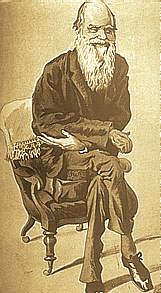 DARWIN’s works were - in contrast to MENDEL’s work - read, criticised, and accepted directly after publication. Although it seemed that in 1859 the time had come to combine the facts and ideas in a selection theory of evolution, at the beginning only few shared DARWIN’s ideas and supported them with observations or experiments of their own.
DARWIN’s works were - in contrast to MENDEL’s work - read, criticised, and accepted directly after publication. Although it seemed that in 1859 the time had come to combine the facts and ideas in a selection theory of evolution, at the beginning only few shared DARWIN’s ideas and supported them with observations or experiments of their own.
Among his opponents was the head of department of the scientific collection of the British Museum, R. OWEN, who looked into problems of descent, too. He coined the still common terms homology and analogy.
DARWIN was, beside others, supported by the geologist C. LYELL, J. D.HOOKER, the director of the Botanical Garden in London, Kew Garden, and the anthropologist T. H. HUXLEY in England. The English newspapers commented on the debate of the opponents with up-to-date caricatures.
In Germany, DARWIN’s ideas were spread and developed by the zoologist E. HAECKEL from Jena (1834 – 1919).
M. SCHLEIDEN took up essential aspects of DARWIN’s theory in the 4th edition of his "Grundzüge der wissenschaftlichen Botanik" (Basic scientific botany) published in 1860. The theory of evolution was reviewed in the "Lehrbuch der Botanik" (Textbook on Botany) by J. v. SACHS (1870, 1st edition), but the author could not follow the idea of selection.
In no work of his, but in his diaries and manuscripts, DARWIN has tried to make up a phylogenetic tree of the organisms. It was E. HAECKEL, who published a first phylogenetic tree of plants in 1866 combining the theory of selection with HOFMEISTER’s results about the alteration of generations.
DARWIN’s ideas about evolution can, as E. MAYR observed (1982, 1984), not be combined in a single theory. Rather, his work about the origin of species is a complex of five independent theories:
![]() evolution itself,
evolution itself,
![]() a common origin of all species
a common origin of all species
![]() a gradual evolution (gradualism)
a gradual evolution (gradualism)
![]() the formation of species as a phenomenon of populations
the formation of species as a phenomenon of populations
![]() natural selection
natural selection
The conclusion alone that evolution has to exist, did – despite the known works of the Frenchmen BUFFON, LAMARCK, and the Swabian natural scientist CUVIER - not correspond to the prevalent views in 19th century England.
The biologists of the second half of the 19th and the first decades of the 20th century adopted some, though not all, of DARWIN’s ideas. In 1901-1903, the Dutch geneticist H. de VRIES, who was one of the three re-discoverers of MENDEL’s laws, did still put forward a mutation theory of evolution based on three postulates:
- The continuous, individual variation is not relevant for evolution.
- Natural selection is unimportant.
Every change in evolution occurs due to sudden, large mutations. Species are subject to periods of mutability and immutability.
During the first half of the 20th century, the term macromutation circulated among geneticists. It was little understood in the early stages of molecular biology, but we know today, that ‘jumping genes’ (transposons) exist and that the adjustability of genes or groups of genes is more important than the change of single genes (point mutations), therefore macromutation is discussed anew.
|
|